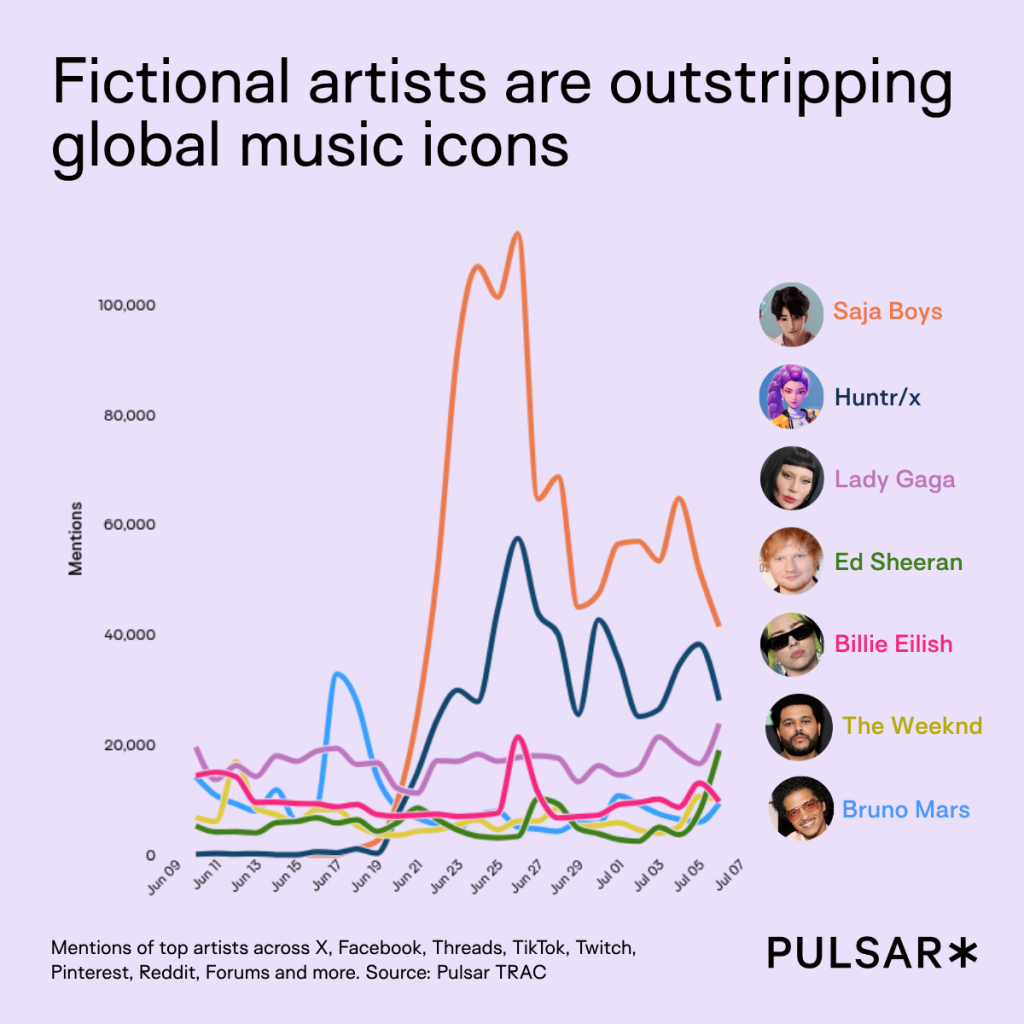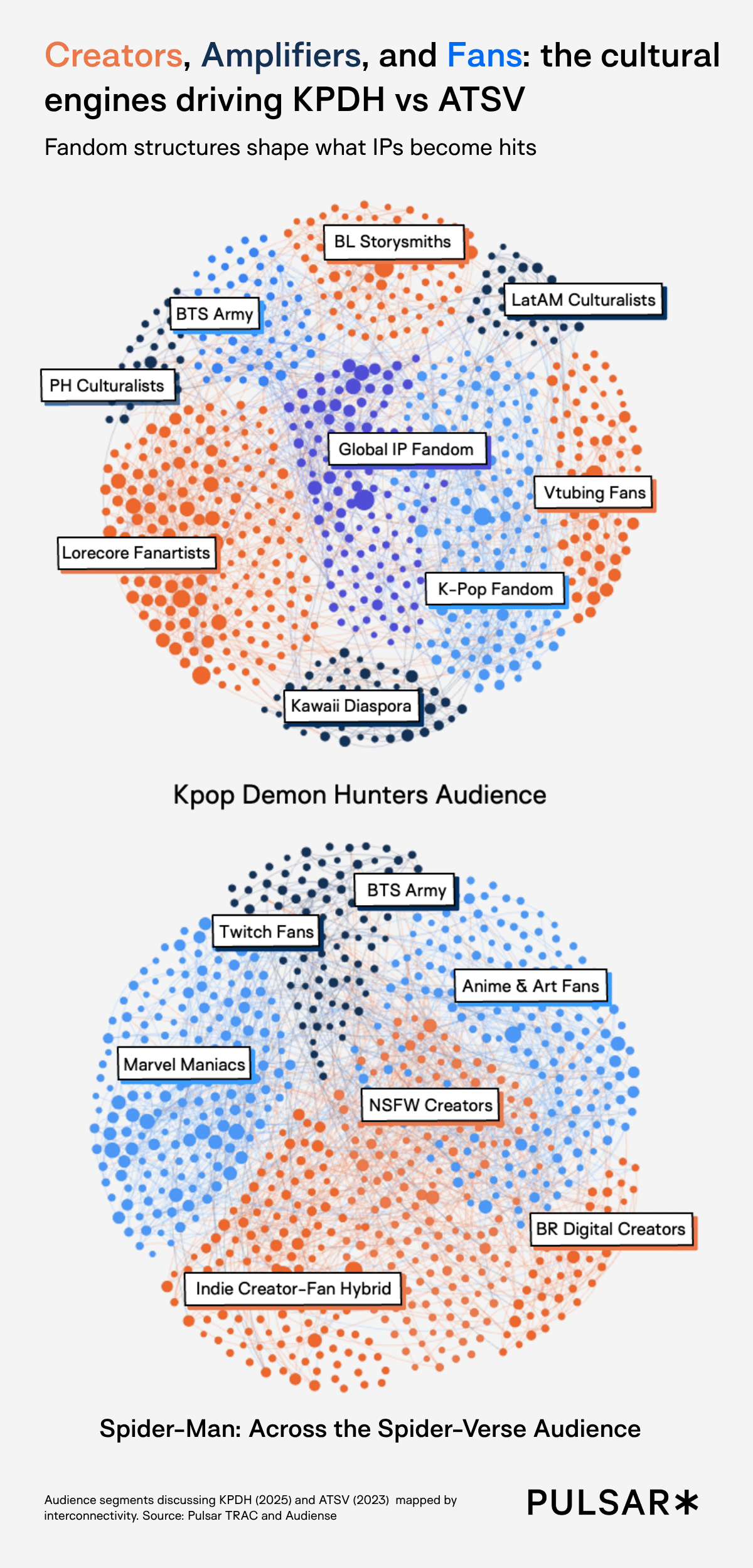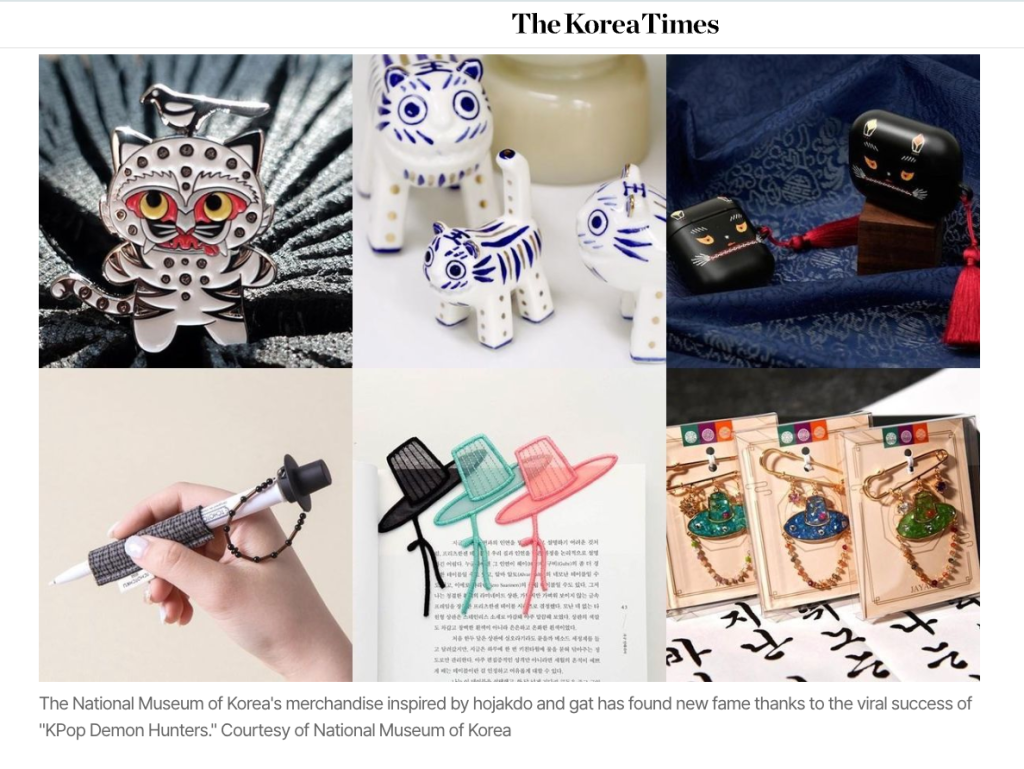
KPop Demon Hunters: How fandom structure turns IP into a hit
- Media & Entertainment
What drives IP breakout in today’s attention economy?
In 2025, it’s how it’s built. And fandoms are the scaffolding.
A crossover of K-pop’s sparkle and occult darkness, rooted in Korean traditional mythology, KPop Demon Hunters (KPDH) quietly dropped its teaser on Netflix in May, prompting low-key excitement in K-pop fandom corners. But just three days after its June 20 launch, it was everywhere: TikTok blew past 15M views, Tumblr overflowed with fan art, and Reddit and Discord turned into full-blown lore labs.
Within a week, it landed in Netflix’s Global Top 10 across 41 countries and racked up 33 million views - surpassing bigger-budget productions and topping social and music charts against real-world artists.

Many chalked its rise up to sheer fandom passion. Partly yes, but the real driver was the way its audience formed a system to organize, produce, and circulate content at scale. And this audience set-up helped KPDH become less a single moment in culture, and more a cultural engine for all kinds of media creation & consumption.
To figure out how this went down, we tracked millions of social data points to see where momentum kicked off and how it spread across X, YouTube, Threads, Facebook, TikTok, Instagram, Pinterest, and more, using Pulsar TRAC.
Table of Contents
The New Arc of Discovery
Unlike most animated launches that blast teasers and trailers beforehand, KPop Demon Hunters quietly slipped in with a teaser that barely registered.

But after the film officially came out, the conversation exploded, surging past 600,000 mentions, the highest for any recent animated release. That’s 4.5x more than the peak of Spider-Man: Across the Spider-Verse.
Even more interesting: the usual hype funnel flipped. Instead of social buzz driving searches, search interest spiked first around June 20’s release, then social mentions surged after. Meanwhile, Korean interest built more slowly.
This inversion - where discovery leads hype - signals a major shift in audience behavior. Fandoms orchestrate the buildup and actively shape anticipation from the ground up. This shift exposes a hard truth: fans now own the hype cycle, dismantling top-down marketing and rewriting how IPs build momentum.
Fandom as a Constellation
So who scaled the KPDH conversation into a full-blown IP? Turns out it wasn’t one audience; it was three working in tandem.
- Amplifiers: Meme pages, viral Threads users, and multi-fandom accounts bridged subcultures and pushed early visibility.
- Stans: The passionate broadcasters and consumers, dropping reaction edits, streaming the soundtrack, and sharing merch hauls.
- Creators: Writers, fan artists, lore builders who spun alternate universes and anchored hype into deep narrative worlds.
At teaser drop, amplifiers and stans jumped first, boosting reach with memes, edits, and reactions. After launch, creators took center stage by building lore, crafting fanfic, and creating entire universes that gave KPDH lasting weight. Amplifiers then pulled new audiences into this growing ecosystem.
This formed a hype-to-substance pipeline: amplifiers light the fire, creators build the foundation, and fans keep it blazing. That’s how a viral moment becomes a living IP, co-authored by its audience.

Turning to the fandom itself, it’s clear KPDH’s rise was powered by structure. When comparing KPop Demon Hunters to another animation powerhouse, Spider-Man: Across the Spider-Verse (ATSV), the difference wasn’t who showed up - it was how they connected.
Both drew creators, amplifiers, and fans, but ATSV’s groups stayed siloed. KPDH’s fandom formed a tight, interconnected web: Fans sat at the center, well connected to and surrounded by both creators and amplifiers, linking the dots. By consuming, remixing, and circulating the IP, they transformed scattered content into a constellation with real cultural pull.
Instead of orbiting a single hub, this network sparked discovery, deepened stories, and kept momentum alive. The fandom became a self-sustaining IP ecosystem - breaking free from Netflix’s narrative to become a cultural force always on.
Fandom Funnels, Cultural Currents
Looking closer, distinct audience groups act less like passive fans and more like distributed marketing engines. In the chart, each group is plotted by volume of posts and total engagement, with bubble size highlighting engagement per post - giving us a view of both scale and impact.
At the heart of it are the creators, especially Lorecore Fanartists, who lead in both volume and engagement. BL Storysmiths also generate strong interaction along with the genre’s rising popularity in fandom culture. By crafting intricate alternate universes and rich lore, often with visually striking formats, these creators deepen the IP’s narrative, encouraging ongoing exploration and return visits.
I will share more later this week, but one of my favorite assignments on #KPOPDEMONHUNTERS was to design ancient hunters! We did a lot of research on Korean historical fashion and I hope we did it justice 💜 https://t.co/rlu80Rxvdd pic.twitter.com/rScRpYEH1y
— Marion 🖍 (@galaxyspeaking) June 20, 2025
Amplifiers, especially Cross-media Enthusiasts, deliver the widest reach by connecting niche fandoms to mainstream culture through memes, news, and personal takes. Many weren’t originally K-pop fans or just casual watchers but quickly became vocal advocates. Their genuine endorsements acted as organic marketing, expanding the film’s footprint and drawing in a wider global audience.
What makes KPOP DEMON HUNTERS so addicting?
byu/fallsintherain inmovies
Amidst the top elements singled out for praise, the soundtrack emerged as a clear favorite...
View on Threads
...as well as relatable storylines, which made the film hit home with mainstream viewers.
Just watched K-Pop Demon Hunters. I'm not even the main target demographic of the genre.
But, the movie is pretty great. Have to commend them for having allegories to Asian shame culture in the movie, as an Asian myself.
Really hits me with shamed Asian parents PTSD.
8/10 pic.twitter.com/hz9KQk9mbg
— miiyauwu | 🟦☁️@miiya.page (@PearlteaRizzy) June 30, 2025
At the same time, fans serve as broadcasters, constantly refreshing the conversation by exploring cultural and musical Easter eggs hidden in the film. Their enthusiasm, coupled with a genuine appreciation of Korean heritage, enriches the narrative around the movie’s cultural layers.
View on Threads
Many in this group also become consumers, purchasing and commissioning IP-related products that sustain the ecosystem beyond digital fandom - so much so that the Korean Museum’s online gift store has already seen record-breaking sales.
 While TWICE fans stand out with the highest engagement ratio, proudly supporting the group's role as main musical contributors to the soundtrack and often encouraging soundtrack purchases on iTunes, the Global K-Pop Fandom also channels its loyalty into consumer behavior - sharing hauls of makeup, collectibles, and branded snacks that hit shelves soon after the release.
While TWICE fans stand out with the highest engagement ratio, proudly supporting the group's role as main musical contributors to the soundtrack and often encouraging soundtrack purchases on iTunes, the Global K-Pop Fandom also channels its loyalty into consumer behavior - sharing hauls of makeup, collectibles, and branded snacks that hit shelves soon after the release.
Why KPop Demon Hunters, Why Now?
The show’s success goes beyond animation or K-pop alone. It landed at a moment when multiple online communities were primed to engage, each finding something that spoke to them.
K-pop fans discovered a new group to stan. Anime lovers got the dynamic fight scenes and rich folklore they crave. Visual Creators found endless inspiration in the striking aesthetics. And Gen Z cross-media audiences encountered a world that felt intuitive - no heavy-handed marketing, just authentic word-of-mouth and instant resonance.
What made KPDH click was its ability to offer different communities a piece of themselves to connect with. In turn, those communities responded by building a vibrant, distributed, self-sustaining system of meaning-making around the IP. It’s a testament to how diverse cultural currents, when woven together through fandom structure, can ignite something much bigger than the sum of its parts.
To stay up to date with our latest insights and releases, sign up to our newsletter below:
This article was created using data from TRAC


